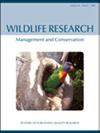Avian assemblages are maintained after aerial applications of ULV fenitrothion for control of the Australian plague locust (Chortoicetes terminifera (Walker)) in arid and semiarid agroecosystems
IF 1.6
3区 生物学
Q3 ECOLOGY
引用次数: 0
Abstract
ABSTRACT Context. Risk assessments currently undertaken to approve pesticides for use against locusts in Australia are predominated by laboratory-generated data, often collected from non-endemic species. Very little information exists concerning the potential ecological effects of insecticides used for locust control. Aims. To determine the effect of aerial ultra-low volume (ULV) applications of the organophosphorous insecticide, fenitrothion (used for locust control), on avian assemblages in arid and semiarid agro-ecosystems. Methods. Avian abundance was surveyed in pesticide-exposed and unexposed locations during standard locust control operations, using fenitrothion, in western New South Wales and Queensland in the spring and summer of 1996, 1997 and 2000, using a transect-point method. Temporal changes in assemblages were analysed using multi-dimensional ordination (MDS) and permutational analysis of variance (PERMANOVA) with PRIMER (V7). Key results. Avian assemblages varied over time, independent of pesticide application, reflecting significant redistribution and mobility of birds across a highly disturbed agricultural landscape, irrespective of pesticide exposure. Additionally, pesticide exposure did not affect species abundance or diversity. Conclusions. There was no evidence that ultra-low volume (ULV) applications of fenitrothion, currently used in locust control, are impacting avian assemblages, despite previous research indicating that individual birds co-occurring with spray operations suffer suppressions in the enzymatic biomarker for OP exposure, plasma acetylcholinesterase (AChE). Implications. Although the risk to avian assemblages associated with the aerial application of locusticides is reduced by the small proportion of the landscape where locust control activities are focused, any change in spray application parameters would necessitate a re-evaluation of the risks associated with insecticide exposure.在干旱和半干旱农业生态系统中,空中应用ULV杀虫剂控制澳大利亚鼠疫蝗(Chortoicetes terminifera (Walker))后,鸟类群落得以维持
抽象的上下文。目前在澳大利亚为批准用于防治蝗虫的农药而进行的风险评估主要采用实验室生成的数据,这些数据通常是从非地方性物种收集的。关于用于防治蝗虫的杀虫剂的潜在生态影响的资料很少。目标确定在干旱和半干旱农业生态系统中,空中超低量施用有机磷杀虫剂灭虫磷(用于防治蝗虫)对鸟类种群的影响。方法。在1996年、1997年和2000年的春夏,在新南威尔士州西部和昆士兰州的标准蝗虫防治行动期间,采用横截点法,在接触杀虫剂和未接触杀虫剂的地点调查了鸟类的丰度。利用PRIMER (V7)软件进行多维排序(MDS)和排列方差分析(PERMANOVA),分析组合的时间变化。关键的结果。鸟类的组合随着时间的推移而变化,与农药的使用无关,这反映了鸟类在高度受干扰的农业景观中的重新分布和流动性,而与农药暴露无关。此外,农药暴露不影响物种的丰度和多样性。结论。尽管先前的研究表明,与喷洒操作同时发生的个别鸟类的OP暴露酶生物标志物血浆乙酰胆碱酯酶(AChE)受到抑制,但没有证据表明目前用于蝗虫防治的超低体积(ULV)杀虫剂对鸟类种群有影响。的影响。虽然空中施用灭虫剂对鸟类种群的风险因防治蝗虫活动集中的一小部分景观而降低,但喷洒参数的任何变化都需要重新评估与接触杀虫剂有关的风险。
本文章由计算机程序翻译,如有差异,请以英文原文为准。
求助全文
约1分钟内获得全文
求助全文
来源期刊

Wildlife Research
生物-动物学
CiteScore
4.30
自引率
15.80%
发文量
56
审稿时长
3 months
期刊介绍:
Wildlife Research represents an international forum for the publication of research and debate on the ecology, management and conservation of wild animals in natural and modified habitats. The journal combines basic research in wildlife ecology with advances in science-based management practice. Subject areas include: applied ecology; conservation biology; ecosystem management; management of over-abundant, pest and invasive species; global change and wildlife management; diseases and their impacts on wildlife populations; human dimensions of management and conservation; assessing management outcomes; and the implications of wildlife research for policy development. Readers can expect a range of papers covering well-structured field studies, manipulative experiments, and analytical and modelling studies. All articles aim to improve the practice of wildlife management and contribute conceptual advances to our knowledge and understanding of wildlife ecology.
Wildlife Research is a vital resource for wildlife scientists, students and managers, applied ecologists, conservation biologists, environmental consultants and NGOs and government policy advisors.
Wildlife Research is published with the endorsement of the Commonwealth Scientific and Industrial Research Organisation (CSIRO) and the Australian Academy of Science.
 求助内容:
求助内容: 应助结果提醒方式:
应助结果提醒方式:


